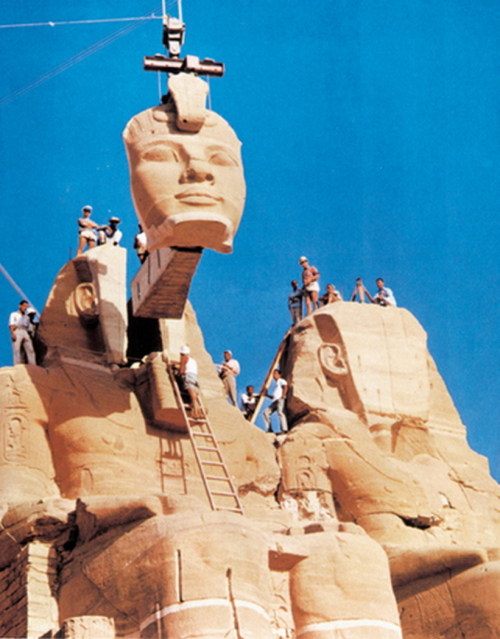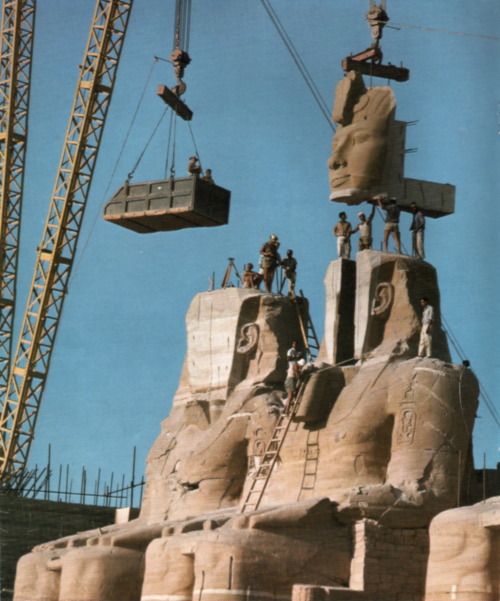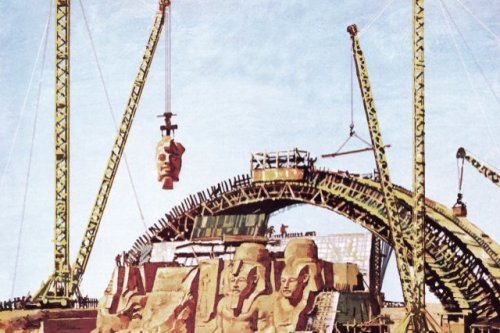How to Move an Ancient Egyptian Temple — The Relocation of the Abu Simbel Temples.In the 13th
How to Move an Ancient Egyptian Temple — The Relocation of the Abu Simbel Temples.In the 13th century BC the mighty pharaoh Ramses II ordered the construction of two large temples in southern Egypt to commemorate his victory at the Battle of Kadesh, to honor his queen Nefertari, and to impress his Nubian enemies to the south. Carved directly into the sandstone hillsides, the large facade of the temples features four colossus statues of Ramses himself, each standing 67 feet in height. The facade itself stands an incredible 100 feet high and 119 feet wide. Inside of the temples are a network of rooms and hallways with many priceless hieroglyphic carvings detailing Egyptian history, religion, and folklore.By the 1960’s the Abu Simbel Temples were a national treasure for the new Egyptian nation. However, Egypt’s industrial modernization would threaten the temples in a way that no pharaoh could have ever predicted. Near Abu Simbel was the construction of a 364 foot hydroelectric dam known as the Great Dam of Aswan. A key objective of the Egyptian government, the dam would provide electricity for the developing nation and kick start a new agriculture plan which would create a massive new irrigation project. However, Abu Simbel was literally in deep trouble, for construction of the damn would leave the ancient temples submerged at the bottom of Lake Nasser.To save Abu Simbel, a team of archeologists, historians, engineers, architects, and construction workers were recruited by UNESCO to conduct one of the most ambitious rescue operations of an ancient structure. The plan was to relocate the ancient temples above the flood plain of Lake Nasser. Incredibly, the team cut the temple facade and structure into individual blocks weighing 20-30 tons. Each block was numbered then recorded as to keep track of where they would go when reassembled. The blocks were lifted out of their original foundation using massive cranes that toward hundreds of feet above the monumental structure. They were then transported to another site where they could be uncatalogued and stored for later. From 1964-1965 over 10,000 stone blocks were cut, lifted, and transported away from the site. The new home for the temples was located 200 meters inland and about 65 meters higher than the original Abu Simbel site. To recreate the look of a temple carved from a sandstone hill, artificial hills were created using concrete which simulated sandstone. Once the new Abu Simbel site was ready, each block was meticulously fitted back into position, reconstructing the ancient temples anew. In fact the reconstruction is so precise that it would impress ancient Egyptian engineers, as on the outside facade of the temples there are no visible seems where the blocks meet. Only a few joins can be found from within the temple complex. The project was completed in 1968 and cost $40 million, over $250 million dollars today. The cost was well worth it as the Abu Simbel complex is considered one of the great treasure of Egypt and is a UNESCO World Heritage Site. Over 500,000 tourists visit the temples every year. -- source link
#histroy#egypt#construction#engineer#ancient egypt#temple#unesco#archeology#abu simbel#lake nasser#temples#aswan dam



